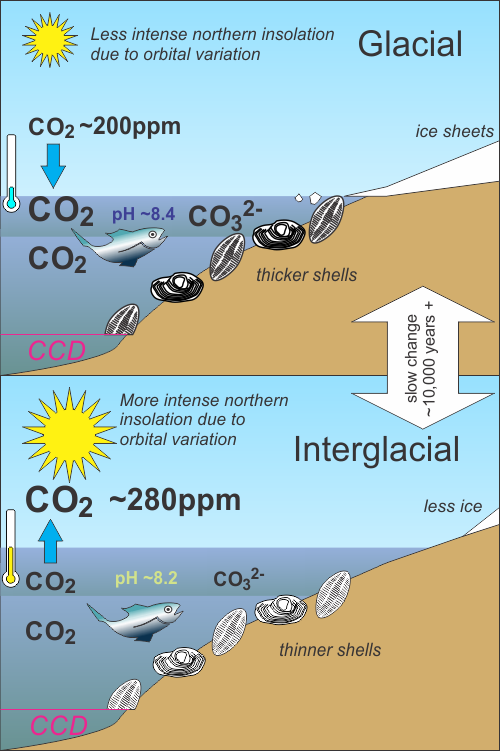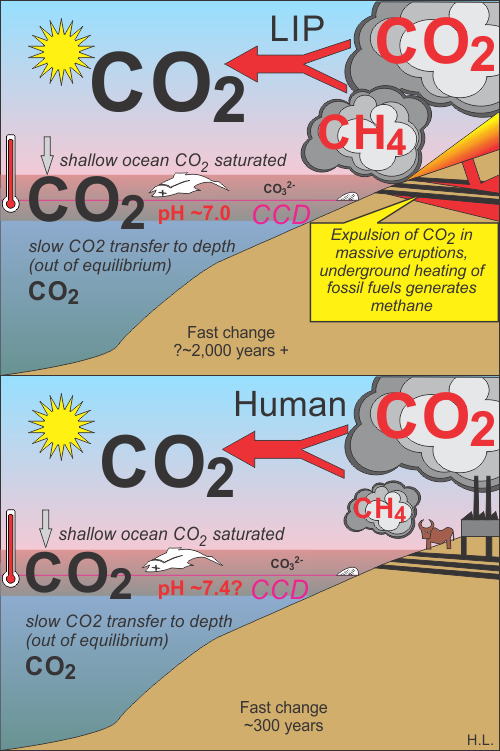
The Permian Mass Extinction 251.9 million years ago, otherwise known as “The Great Dying,” was the closest this planet has come to extinguishing all complex life on Earth. Around 90% of all species died out in this single event, a worse toll even than the Cretaceous extinction that wiped out the dinosaurs.
For years the cause of the Permian Mass Extinction has been linked to massive volcanic eruptions in Siberia. Volcanic CO2 and a cocktail of noxious gasses combined with burning coal and geothermally-baked methane emissions to enact a combination of toxic effects and, most importantly, ocean acidification and global warming. It led to a world where equatorial regions and the tropics were too hot for complex life to survive. That’s a fact so astonishing it bears repeating: global warming led to a large portion of planet Earth being lethally hot on land and in the oceans! The cascading extinctions in ecosystems across the planet unfolded over 61,000 years, and it took 10 million years for the planet to recover! For comparison, our distant ancestors separated from apes only 7 million years ago.
Until recently the scale of the Permian Mass Extinction was seen as just too massive, its duration far too long, and dating too imprecise for a sensible comparison to be made with today’s climate change. No longer.
In “High-precision timeline for Earth’s most severe extinction,” published in PNAS on February 10, authors Seth Burgess, Samuel Bowring, and Shu-zhong Shen employed new dating techniques on Permian-Triassic rocks in China, bringing unprecedented precision to our understanding of the event. They have dramatically shortened the timeframe for the initial carbon emissions that triggered the mass extinction from roughly 150,000 years to between 2,100 and 18,800 years. This new timeframe is crucial because it brings the timescale of the Permian Extinction event’s carbon emissions shorter by two orders of magnitude, into the ballpark of human emission rates for the first time.
How does this relate to today’s global warming?
Climate and CO2 have changed hand-in-hand through most of geological time. Mostly these changes happened slowly enough that the long-term feedbacks of Earth’s climate system had time to process them. This was true during the orbitally-induced glacial-interglacial cycles in the ice ages. In warmer interglacials, more intense insolation in northern hemisphere summers led to warmer oceans which were in equilibrium with slightly more CO2 in the atmosphere by adjusting their carbonate levels. In glacial times with less intense northern hemisphere summer insolation, the cooler oceans dissolved more CO2, and carbonate levels adjusted accordingly. The changes occurred over gentle timescales of tens of thousands to hundreds of thousands of years – plenty slow enough for slow feedbacks like the deep oceans and ice sheets to keep pace.

How oceans processed the slow glacial-interglacial changes in the ice ages. CCD = Carbonate Compensation Depth, CO32- = carbonate. Based on text in Zeebe, Annual Reviews 2012.
Rapid carbon belches, such as in the Permian and today, occur within the timeframe of fast feedbacks (surface ocean, water vapor, clouds, dust, biosphere, lapse rate, etc) but before the vast deep ocean reservoir and rock weathering can cut-in to buffer the changes. The carbon overwhelms the surface ocean and biosphere reservoirs so it has nowhere to go but the atmosphere, where it builds up rapidly, creating strong global warming via the greenhouse effect. The surface oceans turn acidic as they become increasingly saturated in CO2. The oceans warm, so sea levels rise. Those symptoms should sound familiar.

How oceans get overwhelmed by rapid large CO2 emissions from Large Igneous Province (LIP) eruptions and human emissions. CCD = Carbonate Compensation Depth, CO32- = carbonate. Based on text in Zeebe, Annual Reviews 2012.
Burgess et al’s paper brings the Permian into line with many other global-warming extinction events, like the Triassic, the Toarcian, the Cretaceous Ocean Anoxic Events, The PETM, and the Columbia River Basalts, whose time frames have been progressively reduced as more sophisticated dating has been applied to them. They all produced the same symptoms as today’s climate change – rapid global warming, ocean acidification, and sea level rises, together with oxygen-less ocean dead zones and extinctions. They were all (possibly excluding the PETM - see below) triggered by rare volcanic outpourings called “Large Igneous Provinces,” (LIPs) that emitted massive volumes of CO2 and methane at rates comparable to today’s emissions. The PETM may also have been triggered by a LIP, although that is still debated.
Can we seriously expect Earth’s climate to behave differently today than it did at all those times in the past?
Some have pointed out that since we began our modern climate change in an “icehouse” era with ice sheets to melt and low starting CO2 levels, we might not generate a Permian-like hothouse. In addition, since the Permian, calcareous algae have changed the way deep oceans process carbonate, providing more of a buffer. But that buffer only comes into play if the deep oceans come into play, which most estimates consider won’t happen for a few more centuries.
All in all, the parallels between the many mass extinction events in the geological record and today’s climate change offer no comfort about the legacy we’re leaving for our children and our grandchildren. Rather they stand as signposts for an increasingly scary future.
Posted by howardlee on Wednesday, 2 April, 2014
 |
The Skeptical Science website by Skeptical Science is licensed under a Creative Commons Attribution 3.0 Unported License. |